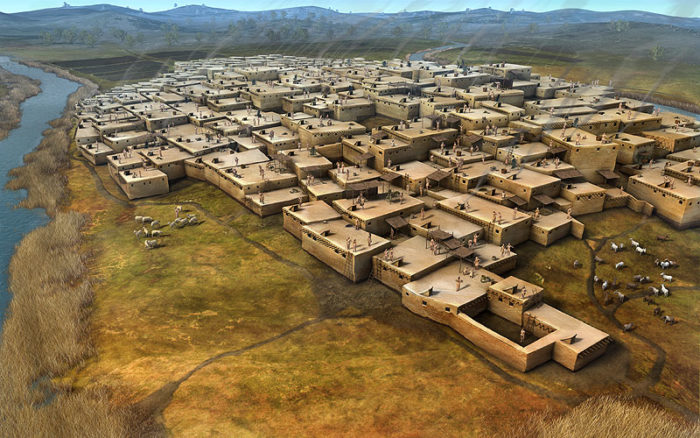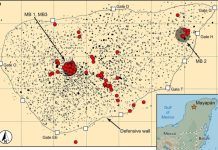The world is full of ruined cities, but some have such mysterious rises and falls that they haunt our imaginations.
Even if we know who built them, certain aspects of the city may simply defy comprehension in the modern age. Here are 8 ancient cities that we may never fully understand.
Çatalhöyük, Turkey
In 7,500 BCE, this city in the Mesopotamian region (now Turkey) held thousands of people and is believed by many to be one of the world’s earliest urban settlements. But the culture of the people here was unlike anything we know today. First of all, they built the city like a honeycomb, with houses sharing walls. Homes and buildings were accessed by doors cut into the roofs. People would stroll on the streets across these roofs, and climb down ladders to get to their living quarters. Doorways were often marked with bulls’ horns, and dead family members were buried in the floor of each home.
Mysterious ruined cities: Çatalhöyük in Turkey. Photo: Franck Goddio
It’s not clear what happened to the culture of the people who lived in this city. Their architectural style seems to be unique, though archaeologists have found many fertility goddess figurines in the city that resemble others found in the region. So it’s likely that when the city was abandoned, its culture radiated outward into other cities in the Mesopotamian region.
Teotihuacan, Mexico
I chose Teotihuacan over Palenque. Indeed, they thrived between the 700BC through the 700AC and no one knows where they came from. But what’s best, no one knows where they went. They were traders in the best sense of the word, with “consulates and diplomats” from other civilizations living in town, with a “diplomatic” district representing each tribe of the entire Mesoamerican region. Artifacts found range from pacific side sea shells to caribbean art figures. It is known that they traded with Mayans, Olmecs and northern tribes.
It was abandoned before the rise of the Aztec empire. Nevertheless, Aztecs traveled from Tenochtitlan to Teotihuacan to hold solstice rituals and other important religious practices in the city ruins.

Highly advanced for their time, Teotihuacanons excelled in maths, astrophysics and architecture. Also, Teotihuacan was, at it’s peak, the largest city in the world, holding +150k people within its borders. To date, no one is really sure about what happened to Teotihuacanos. Theories range from diseases and famines to aliens. Maybe we’ll never know for sure. But once you visit these ruins, you can never stop wondering about Teotihuacan and its people…
Cahokia, United States
Located across the Mississippi River from what is today St. Louis, Cahokia was for hundreds of years the biggest city in North America. Its inhabitants built enormous earthen mounds — some of which you can still visit today — and vast plazas which served as markets and meeting places. There is strong evidence that the inhabitants had very sophisticated agricultural practices, and that they diverted tributaries of the Mississippi several times to water their fields.
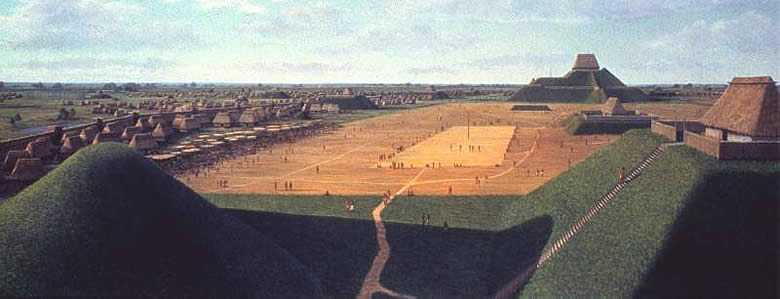
Like the Maya, the people of Cahokia were at their civilizational height between 600-1400 CE. Nobody is certain why the city was abandoned, nor how the region was able to support such a high-density urban civilization of up to 40,000 people for hundreds of years.
Derinkuyu, Turkey
Derinkuyu is an enormous, ancient underground city that dates back to the early Byzantine Empire. It’s unknown when the city was begun — some sources say as early at the 7th century BCE — but it wouldn’t have reached its greatest size until the period between 500-1000 CE, when it was five stories deep with room for 20,000 people, plus livestock, kitchens, a church, and a wine-making facility. Locals dug tunnels and rooms beneath their homes, deep into the soft, sandy volcanic rock of the central Turkish region of Cappadocia. An entire underground civilization was thriving here during the middle ages, which could provide a model for future communities trying to survive an apocalypse.
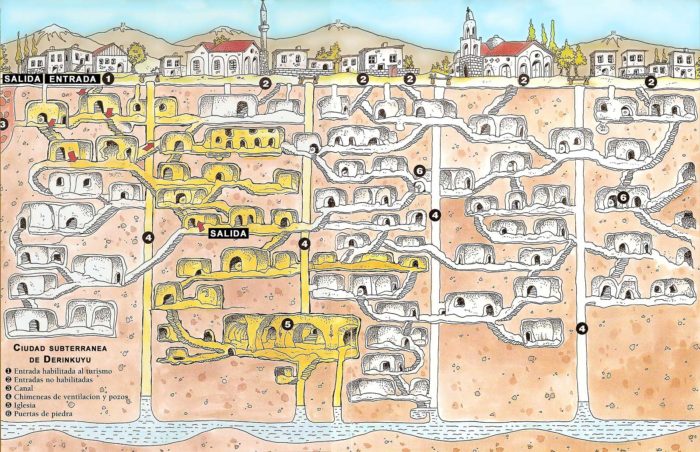
For centuries, people had fled to the area to find a safe haven from anti-Christian Romans, bandits, and later, anti-Christian Muslims. Massive rocks could be rolled across the entrances, and air shafts kept the place ventilated while people lived inside for months at a time. Eventually, long shafts were dug to connect Derinkuyu with other underground cities in the area. The city was sealed up at some point after the 10th century, and was only reopened to the public in 1969.
Pompeii, Italy
There are ample historical records that document the Roman vacation town of Pompeii, which was entombed in ash after the catastrophic eruption of Mt. Vesuvius in 79 CE. We know that the city was partially destroyed by an earthquake years before the volcano erupted, and that many of its greatest homes were already abandoned by the time the final blast erased the city forever. We even know, from historical records, that Vesuvius started smoking and causing quakes in the days leading up to the fatal eruption. So what’s the mystery?
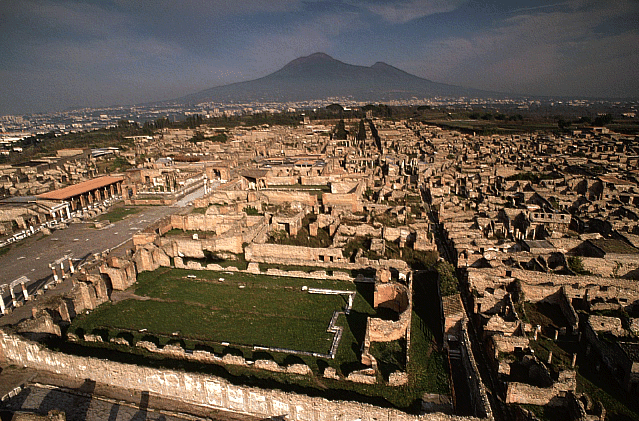
Because Pompeii was perfectly preserved in the exact configuration it had in 79 CE, there are hundreds of historical details that are utterly alien to contemporary eyes — including decorative penis statues, weird graffiti, inexplicable art, and living arrangements that are unlike anything you’d see in a modern city. It’s one thing to read historical accounts of ancient Rome, and another thing to walk the streets of a Roman city unchanged since the height of the Empire. The mysteries of everyday life are often greater than the mysteries of how a civilization collapses.
Machu Picchu, Peru
A lot remains mysterious about the Inca Empire, which dominated parts of the regions now known as Peru, Chile, Ecuador, Bolivia and Argentina for hundreds of years before the Spanish invaded, destroyed its cities, and burned its libraries of quipu records (the Inca language was “written” with knots and rope). Though we know a lot about Inca technology, architecture and advanced agriculture — all of which are in evidence at major Inca city Machu Picchu — we still can’t read what’s left of the tapestries that contain their written records.

And we don’t understand how they ran a vast empire without ever building a single marketplace. That’s right — Machu Picchu and other Inca cities contain no markets. This dramatically different from most other cities, which are often built around central market squares and plazas. How did such a successful civilization exist without a recognizable economy? Maybe one day we’ll discover the answers.
Thonis, Egypt
In the 8th century BCE, this legendary city was the gateway to Egypt, a port town that was full of incredible monuments, rich merchants, and huge buildings. Now it is entirely submerged in the Mediterranean Sea. Thonis began its slow decline after the rise of Alexandria in the 300s CE. But eventually that slide became literal, as the city drowned in the sea that was once the source of its wealth. Nobody is certain how it happened, but by the 8th century CE the city was gone.
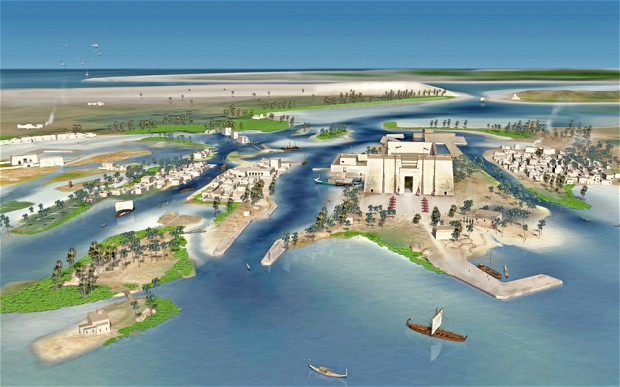
It may have been the victim of liquefaction after an earthquake. Recently rediscovered by archaeologist Franck Goddio, the city is slowly being excavated. Above is a video reconstruction of what the city might have looked like in its heyday.
Great Zimbabwe, Zimbabwe
One of the great mysteries of southern Africa is the enormous, walled city known today as Great Zimbabwe. The city was home to as many as 30,000 people, and was at its peak from 1200-1450, when it was the heart of an international trade region that stretched as far as China and India. Wealth poured into the city from distant lands, but it was also rich in gold from local mines and vast herds of cattle. Still, there are some unknowns here — it’s not clear how far the city’s influence stretched, nor what all its industries were. Clearly, though, it was technologically advanced. The BBC describes the greatest remaining monument from the city:


